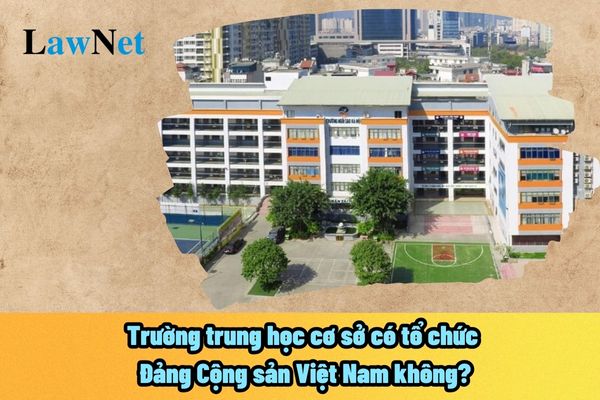Do lower secondary schools in Vietnam have an affiliate of the Communist Party of Vietnam? Are there public and private lower secondary schools in Vietnam?
Do lower secondary schools in Vietnam have an affiliate of the Communist Party of Vietnam?
Pursuant to the provisions of Article 9 of the Charter for lower secondary schools, upper secondary schools, and multi-level general schools issued with Circular 32/2020/TT-BGDDT:
Organizational structure of secondary schools
Organizational structure of a secondary school comprises the school council; principal and deputy principal(s); emulation and reward council; discipline councils; advisory councils; affiliate of the Communist Party of Vietnam; affiliate of trade union; affiliate of Ho Chi Minh Communist Youth Union; affiliate of Ho Chi Minh Young Pioneer Organization; specialized teams; office team; and units in charge of educational activities characteristic of the school.
The organizational structure of a secondary school includes:
- The school council;
- The principal and vice-principal;
- The affiliate of the Communist Party of Vietnam; affiliate of trade union; affiliate of Ho Chi Minh Communist Youth Union; affiliate of Ho Chi Minh Young Pioneer Organization;
- The emulation and reward council; advisory councils;
- Specialized teams; office team; and units in charge of educational activities characteristic of the school.
Therefore, lower secondary schools in Vietnam must have an affiliate of the Communist Party of Vietnam

Do lower secondary schools in Vietnam have an affiliate of the Communist Party of Vietnam? Are there public and private lower secondary schools in Vietnam? (Image from the Internet)
Are there public and private lower secondary schools in Vietnam?
Pursuant to the provisions of Article 4 of the Charter for lower secondary schools, upper secondary schools, and multi-level general schools issued with Circular 32/2020/TT-BGDDT:
Secondary school types and systems
1. There are two types of secondary schools: public schools and private schools.
a) A public secondary school is established and directly managed by the competent authority. The school’s facilities and recurrent expenditures are mostly covered by state budget.
b) A private secondary school has its establishment invested in and operating conditions guaranteed by a foreign or Vietnamese investor and is established under the law. The school’s facilities and operating expenses are not covered by state budget.
...
Secondary schools are organized into two types:
Furthermore, "secondary school" is a general term for lower secondary schools and other schools (according to Clause 2, Article 1 of the Charter for lower secondary schools, upper secondary schools, and multi-level general schools issued with Circular 32/2020/TT-BGDDT)
Additionally, the position of secondary schools within the national education system is also defined in (Article 2 of the Charter for lower secondary schools, upper secondary schools, and multi-level general schools issued with Circular 32/2020/TT-BGDDT)
"Secondary schools are general education institutions within the national education system. These schools have juridical personality, their own accounts and seals."
Therefore, according to the regulations, lower secondary schools can be both public and private.
Does the principal of a secondary school in Vietnam need to recruit teachers to teach at the school?
Pursuant to the provisions of Clause 1, Article 11 of the Charter for lower secondary schools, upper secondary schools, and multi-level general schools issued with Circular 32/2020/TT-BGDDT:
Principal and Vice-Principal
1. Principal
...
d) Duties and powers of the principal:
- Build and organize the school’s apparatus according to regulations in Article 9 of this charter; appoint department/unit heads and deputy heads; and establish the school council as per regulations in Points dd and e Clause 1 Article 10 of this charter;
- Formulate the school’s development planning, objectives, vision and strategies; the school’s organizational and operational regulations; and the school’s annual education plans, which shall be proposed to the school council for approval and implementation;
- Adopt the school council’s decisions or conclusions concerning the matters mentioned in Point c Clause 1 Article 10 of this Decree. In case the principal does not agree with a decision from the school council, obtain the opinion of the supervisory education authority. While waiting for said opinion, the principal must abide by the parts of the school council’s decision that are not against existing regulations of law and this charter;
- Submit reports on and assessment of implementation of the school’s education plan and decisions issued by the school council to the school council and competent authorities;
- Recruit and manage teachers and staff; sign labor contracts with teachers and staff, and receive and relocate teachers and staff; manage academic matters; assign tasks to teachers and staff, inspect and evaluate teachers and staff; and reward and discipline teachers and staff as prescribed by law;
- Manage students and student activities organized by the school; approve student assessment results, sign school report books, sign written confirmation of completion of primary education program for primary school students (if any) of multi-level schools, grant certificate of completion of general education program to upper secondary students (if any) and decide rewards and discipline for students;
- Manage the school’s finance and property;
- Provide state benefits for teachers, staff and students; comply with regulations on democracy and accountability of heads of educational institutions in organization of their institutions’ activities; facilitate privatization of education in the school;
- Direct emulation movements and campaigns; provide transparency to the school and the society as per the law;
- Join meetings of specialized teams; self-learn to improve professional capacity and managerial capability; be entitled to benefits offered to teachers and incentive policies as prescribed by law; and may teach in compliance with regulations on teaching hour norms for principals;
- Hold the right to receive training to improve professional capacity and qualifications and be entitled to benefits prescribed by law.
Therefore, according to the above provisions, one of the duties and rights of the principal of a secondary school is to recruit teachers to work at the school under the principal's management.

